If you’re traveling with kids or just want a local experience, Finca El Paraiso is a great activity for your time in Monteverde. Our family recently did their farm and cheese tour, and the Vargas family welcomed us with open arms. In this post, we’ll tell you about their sustainable dairy farm and what to expect on a visit.

Location
Finca El Paraiso (Paradise Farm) is located near the town of Santa Elena in a region called Monteverde. This area is higher altitude and known for having lush cloud forest.
For more information about Monteverde, read our full destination guide, Monteverde: A Forest in the Clouds.
The Tour
Introduction
Our family pulled up the dirt driveway and parked outside a simple metal structure. All around us were grass-covered hills and forest.
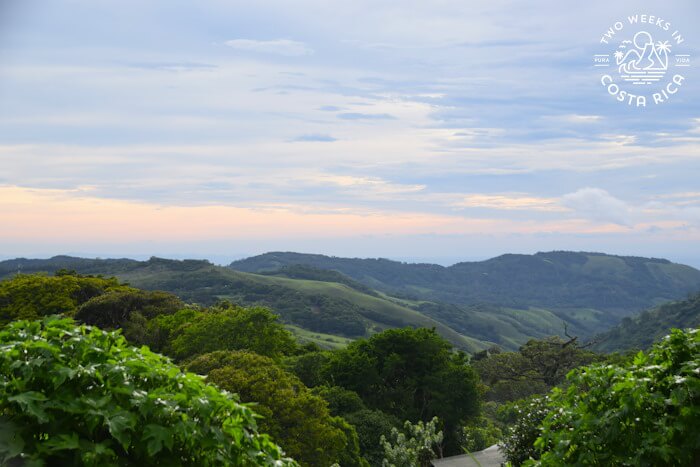
Carolina, one of the family members, greeted us right away. With a big smile, she told us she would be our guide for the day.
Finca El Paraiso is a family farm. Carolina is the daughter of the owners, Orlando and Yolanda, who we would meet later on. Together, along with her brother, Orlando junior, they work the farm and offer tours.
Background
Finca El Paraiso has been around for three generations. Carolina’s grandfather came to Monteverde in the 1950s for farming and coffee. He bought a large parcel of land (around 800 hectares/1,977 acres). The family split it up among the individual members.
The land that the farm is on today consists of 10 hectares (25 acres). About half of that is farmland, while the other half is primary forest, meaning it has never been cut down.
The family started dairy farming about 25 years ago. They used to use traditional farming methods but stopped using chemicals about six years ago.
In Costa Rica, it is very common for farmers to use pesticides and chemical-based fertilizers to control insects, weeds, and disease, and to make plants grow faster. Wanting a more natural, sustainable approach, the family stopped using sprays and changed their farming methods.
Regenerative Farming
Carolina led us down a path through the forest to the fields.
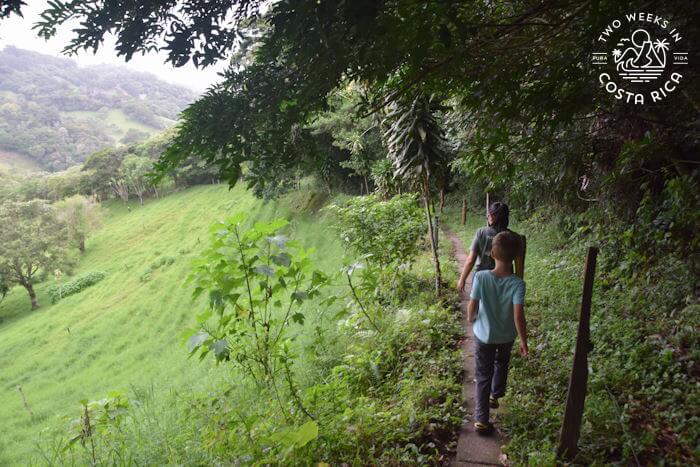
Looking through the trees, she explained that when they switched to organic, they started using regenerative farming.
Under this method, the cows graze in a smaller fenced area of the field for one day, then are moved to a new area the next day. This is a more sustainable approach as the cows eat all the grass and plants in that one section rather than favoring certain types that they prefer. In this way, the family doesn’t need to use herbicides to then kill the “weeds” that would normally be left behind by the cows.

Fertilization of the fields happens naturally. After the cows are moved to a new field, other animals, like armadillos and coati, come and move the dirt and droppings around.
In 45 days once the field has regenerated and plants and grass have returned, the cows will come back to same section and the process repeats.
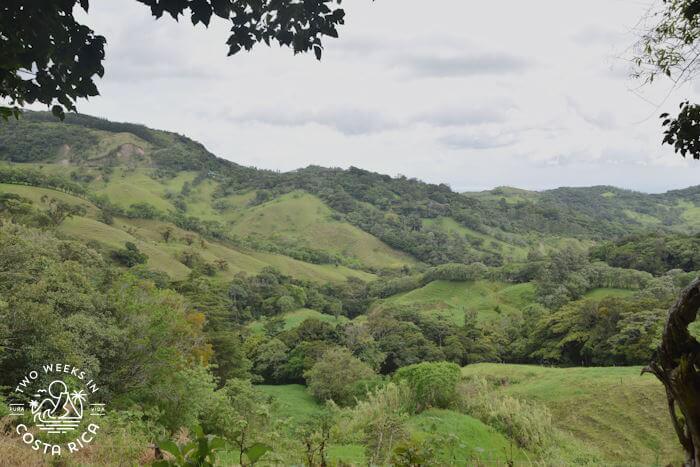
Using this sustainable approach, the farm produces less milk overall. This is because there is less grass and plants to eat than if they used chemicals, so they can’t have as many cows.
However, the quality of milk is much better because of the cows’ varied diet. And it benefits the people and the environment by using less chemicals.
Regenerative farming has its challenges, but Carolina explained that the family thinks it is the best option.
Milking a Cow
After learning about the farm, it was time for the fun part: meeting the animals.
Carolina first brought us into the milking barn.
At Finca El Paraiso, they milk with machines. We learned that it takes about three to five minutes per cow, and they set the cows up with some hay while they’re waiting. They had nine milking cows when we were there. Another five were pregnant.
Those nine cows produce about 100 liters (26 gallons) of milk per day!
They sell their milk to the Monteverde Cheese Factory. Every two days they come in a truck to get it.
After hearing about the process, we had the chance to milk a cow ourselves. Orlando senior showed us how to do it by hand. The kids weren’t interested, but Matt tried it. Following Orlando’s technique, he was able to squeeze a good amount into a coffee mug.
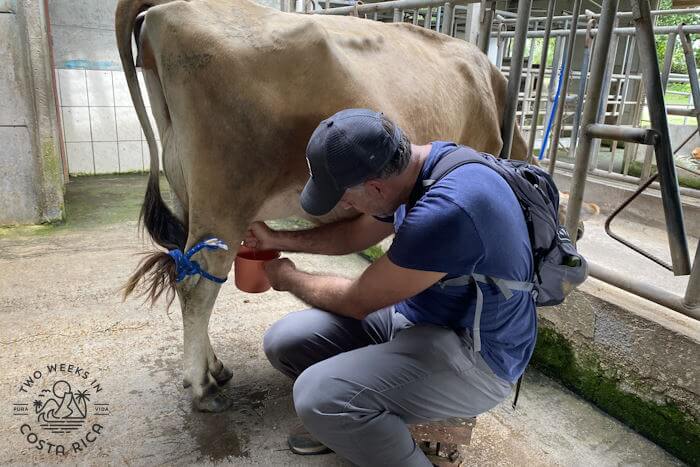
Orlando invited us all to try the fresh milk and even put some cocoa and sugar in it to make chocolate milk for the kids. It was creamy and delicious.
Baby Cows and Pigs
In the small barn next door, we met some of the babies at the farm.
There was Claudia the piglet, some charming calves named Roseta, Reina, Princesa, and Luna, and a few goats.
Our boys, Sam and Evan (ages 7 and 4 at the time), got to feed them. We watched as the animals happily slurped down milk from a bottle and chomped some fresh sunflower greens.
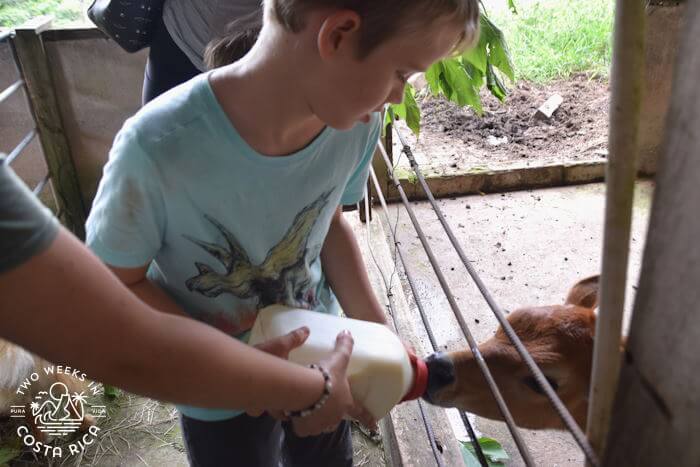
Making Cheese
After feeding the animals, we met Yolanda back at the main building to make homemade cheese.
Costa Rica has several types of fresh cheese made from cow’s milk. Yolanda stood on one side of the stainless steel counter and explained to us that we would be making a soft, mild cheese, popular in the Guanacaste region of Costa Rica.
Cheesemaking was a lot easier than we had expected.
We first added rennet to the farm-fresh milk and let it sit for 20 minutes. After, we stirred and the mixture separated into the solid curds and liquid whey.
Yolanda then scooped out the curds and put it in a cheesecloth to strain out the last bit of whey. We just had to give it some time and then the cheese would be ready.

From there, we started making tortillas. Yolanda prepared the dough then gave us each a piece to form into a ball and roll out. She and Carolina helped our youngest son pat it down until it was flat and round.
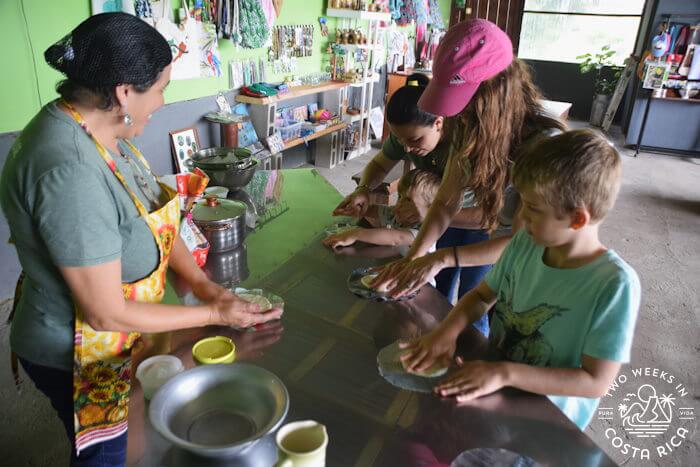
Yolanda then cooked them for a few minutes on the stove until they puffed up and browned slightly.
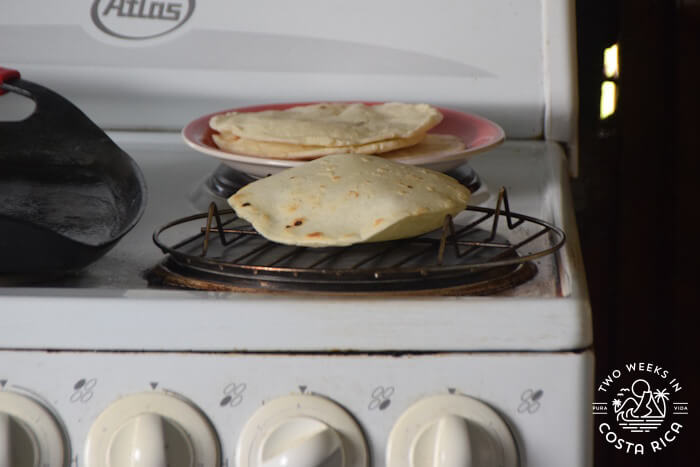
Taste Testing
With the delicious smell of fresh tortillas wafting in the air, we couldn’t wait to try our creations.
We sat at the rustic wooden picnic table, and Yolanda and Carolina brought us each some cheese along with the tortillas that we had made. We enjoyed them alongside coffee for the adults and sugar cane juice for the kids.
The warm tortillas were delicious with the mildly tangy fresh cheese. It was the perfect way to end the afternoon.
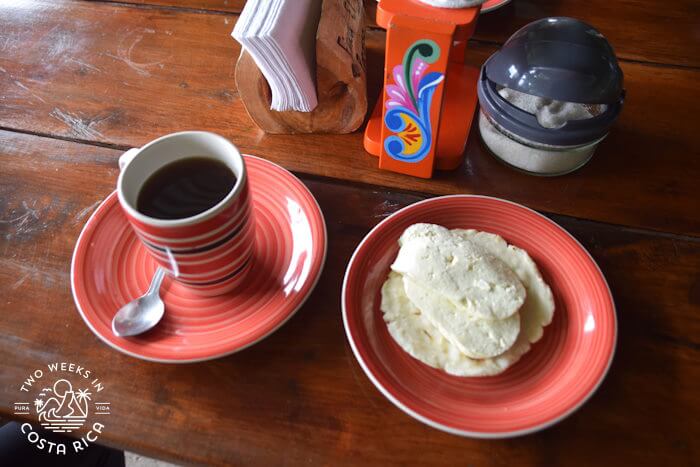
Planning Your Visit to Finca El Paraiso
Cost
Farm and Cheese Tour: $38 per person adults, $28 per person children ages 7-17.
Duration
About 2 hours
Other Tours
Finca El Paraiso has other cooking tours as well. You can find more information on their Trip Advisor page.
How to Book
Tours can be booked through Finca El Paraiso’s TripAdvisor page or on Viator.
Conclusion
If you’re looking to visit an authentic family farm during your trip to Costa Rica, we highly recommend Finca El Paraiso in Monteverde. Our family, especially the kids, loved seeing the farm, getting to interact with the animals, and making some farm-fresh foods.
Have a question about the farm tour at Finca El Paraiso? Ask us below.
If you book a tour using the link above, we receive a small commission at no extra cost to you. Thanks for supporting our website!
Looking for more information to plan your trip to Costa Rica? Check out these posts:
Manuel Antonio Bee Farm: This is another type of farm tour but also a very authentic experience.
Monteverde Tours: A guided cloud forest hike is a must in Monteverde. If you’d like help arranging a guide, we work with an excellent one. Check out the tour options here.
A Night Walk in Monteverde: Sleeping Toucans, Sloths & Snakes – Read about our experience on a night tour in Monteverde.
Arenal Ecoglide: Family-Friendly Zip Lining – If you’re looking to zip line with the kids, Ecoglide is a great option.
